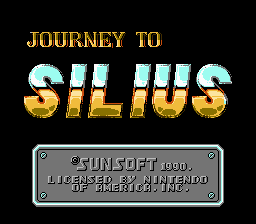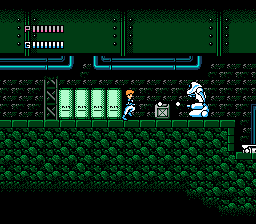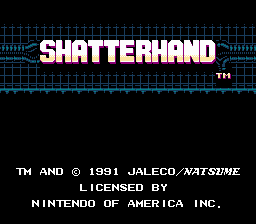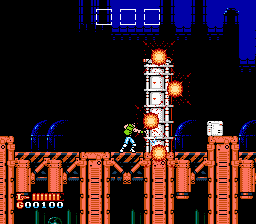#25 - Ninja Gaiden
Unbreakable Determination (Stage 4-2)
Listen to this track:
Requires Flash10
Track information:
| Game title: |
Ninja Gaiden |
| Track title: |
Unbreakable Determination (Stage 4-2) |
| Game release year: |
1989 |
| Composers: | More Yamasan, B. Hasake, Miyazaki |
| Download: |
NSFE
(complete), NSF (track 15)
|
|
Review by Jace:
|
|
More of that uniquely-NES Disco Metal! Perhaps I use the term "metal" a tad hastily, though. It's energetic. It "rocks." However, there's something about the melody that makes it sound somewhat out of place on guitars to me. Similarly, the square wave augmenting the main melody does not seem to be attempting to emulate "distorted rock guitar" at all. It has a clean, plucking tone more reminiscent of a banjo or even someone shredding a zither (though tuned with unreal precision in that case). Some of the coolest and most memorable NES music really inhabits its own unique genre; I have yet to encounter an arrangement of this song that I think captures the energy and style of the original, and I can't think of anything quite like it in contemporary music. |
|
#24 - Castlevania 3 - Dracula's Curse
Prelude (Introduction)
Listen to this track:
Requires Flash10
Track information:
| Game title: |
Castlevania 3 - Dracula's Curse |
| Track title: |
Prelude (Introduction) |
| Game release year: |
1990 |
| Composers: | Yoshinori Sasaki, Jun Funahashi, Yukie Morimoto |
| Download: |
NSFE
(complete), NSF (track 22)
|
|
Review by Norrin_Radd:
|
I'll be the first to admit, I am pretty terrible at this game. Even as a kid with the game genie, I never made it far enough in the game to hear all of the music. However, this song... This song I knew very well, as it greets you every time you turn the game on. Right from those very first few notes the sound team for this game go to extreme measures to create a rich and unique sound. I can think of no other NES game that created a sound quite like these first few notes in this song, and as a result, they cut right through my filters, and hit deep. Strangely enough, this amazing sound that they created never returns during the song, or even further in the game (that I can tell). It's almost as if they wanted the very moment you turn this game on to always stand out, and I can definitely attest to that. Every time I hear it, I get this little ping in the back of my brain.
Beyond that incredible opening to the song, you are suddenly hit with a shockingly somber and mature sounding prologue track. Don't get me wrong, previous Casvlevania games had somber and mature sounding themes (the ending to Simon's Quest for example), but this was the first Castlevania to feature an intro sequence with music. For all I can tell, this was probably the finest example of a game that was really trying to transcend the stereotype of what "videogames" could be. Especially with music like this intro piece.
Naturally, there are a bevy of techniques going on at all times with the square waves. If you solo either square waves, you will usually be able to hear just how much effort went in to each one to make it sound as vibrant and full as it could. For those of you who aren't really familiar with how the NES composers did this. They would basically look at the space between any and every two notes, and determine whether or not they could squeeze in a very short and much quieter version of a previous note. So, instead of ever hearing silence, you will instead hear the echoes of notes that were hit earlier. That way they don't have to use another channel for reverb or echoes. They can do it all in the one channel. It's pretty much accomplished by looking at available space, and assigning priorities to it. Unless the space in between notes is meant to be utterly silent, why not fill it will the note that just played, or the one before that?
The writing of the square waves is also worthy of mention. To me it sounds great. A very well thought out and dark sounding theme. But the thing that interests me the most about the square waves now is the backup square wave, not the lead. It really is amazing how it can be plucking away at it's own little counter melody, then instantly sync up with the lead and harmonize for a few notes, then plop right back to the counter melody. It's this kind of writing that really makes me glad this project happened, and we are all giving these tracks some well due attention. |
|
#23 - Journey to Silius
Stage 2
Listen to this track:
Requires Flash10
Track information:
| Game title: |
Journey to Silius |
| Track title: |
Stage 2 |
| Game release year: |
1990 |
| Composers: | Mabocha N, Marumo, Naoki Kodaka, Nobuyuki Hara,
Shinichi Seya |
| Download: |
NSFE
(complete), NSF (track 6)
|
|
Review by Jace:
|
|
This song exhibits a masterful understanding of how the anatomical materials available to NES composers (two square waves, one triangle, a noise channel, and maybe some simple samples) can be molded together to form a whole that is much greater than the sum of its parts. There's both a cavernous quality and a softness to the melodic leads; these qualities are achieved with a combination of simple volume manipulation and duty cycle selection, combining with a slightly over-the-top vibrato to lend the song a powerful and earnest sense of mournfulness eclipsing almost anything else in that mood on the system. The drums sound big and human in a way that must have dropped the jaws of lesser NES composers who might have heard this music around the time it was released, but if you open up the .nsf file for the song and isolate the sound channels so that only the triangle and noise channels are heard, you'll find that what's really happening is, like so many brilliant ideas, rather simple, and that it sounds much smaller without that classic sampled Sunsoft bassline. The true masterstroke for the composer here is understanding the ways that the triangle and noise drums would be magnified and intensified by that sampled bassline, which itself adds no raw percussive elements. However, what I perhaps appreciate most of all as a listener is that this song, being composed of long A, B and C sections, tricks you into thinking it's going into a loop 33% sooner than it actually does. The joy of this discovery is one of the things that makes Journey to Silius' music so unique and powerful among its counterparts, saying to me that even in the crush of the post-apocalyptic game world that these sounds inhabit, there is something that's worth looking forward to, something worth living and fighting for. |
|
#22 - Mega Man 2
Epilogue
Listen to this track:
Requires Flash10
Track information:
| Game title: |
Mega Man 2 |
| Track title: |
Epilogue |
| Game release year: |
1989 |
| Composers: | Manami Matsumae, Yoshihiro Sakaguchi, Ogeretsu Kun |
| Download: |
NSFE
(complete), NSF (track 22)
|
|
Review by Ryan8bit:
|
|
This track definitely has a large place in the hearts of many because of the tie to such a beautiful, yet strange ending to a classic game. There is nothing inherently complex about it, but it is insanely emotional. The arrangement itself is very minimal with just the triangle bassline and echoing square lead with the occasional peppering of some percussion. Such minimalism is perfect for capturing a somber moment that transcends time. But most importantly is the spine chilling ending. It could have taken the bittersweet song, focused on the positive and ended on a major chord similar to what we hear in Castlevania III's "Evergreen," but instead it's left on a forlorn note. It really makes you contemplate why Mega Man is so pensive, or what is exactly happening when he leaves his helmet there in the grass. It also draws to mind parallels to the ending theme of The Incredible Hulk television series. Both songs imply a lonely journey where the destination is uncertain. It's a simple, but incredibly effective piece. |
|
#21 - Solstice - The Quest for the Staff of Demnos
Title Screen
Listen to this track:
Requires Flash10
Track information:
| Game title: |
Solstice - The Quest for the Staff of Demnos |
| Track title: |
Title Screen |
| Game release year: |
1990 |
| Composer: | Tim Follin |
| Download: |
NSFE
(complete), NSF (track 6)
|
|
Review by Jace:
|
|
Tim Follin: one of the most vocal and heralded classic VGM composers, but also one of the most paradoxical in that he has publicly degraded his synthesized and sample-based computer music while simultaneously being regarded as one of the undisputed masters of the form. When asked which computers he hated writing music for the most in a 1998 interview, he singled out the AY chip, stating as an aside that "the NES wasn't much better, but at least it had a bit more character." And for sheer "character," hardly any single NES tune stands out as much as this Solstice song. Follin has also stated that he was obsessed with getting synthesized and sampled music to sound "real," like "real players playing real instruments," and it really shows (amazingly) in this work. We can identify flute, violin, guitar (lute?), analog drum kit, piccolo, clarinet, and more. However, there's also this other thing, this uniquely NES TIM FOLLIN THING, the supernova explosion of square wave arpeggios and triangle wave drum sounds indicating a genius-level comprehension of the limitations (and possibilities) of his medium that makes the modern-day scorn of Mr. Follin a shame to behold. From a melodic perspective, there's arguably a little too much going on here for the average ringtone-seeking mega-nerd to latch on to. It's kind of the ultimate connoisseur's work. As impossible as it seems, this song was created only using the exact sound channels available to, well, every single other NES composer. No extra sound chips, not even any samples, just a fiery ingenuity and an apparent interest in obscuring the limitations of the source into something larger than its component parts. |
|
#20 - Bionic Commando
Enemy Base
Listen to this track:
Requires Flash10
Track information:
| Game title: |
Bionic Commando |
| Track title: |
Enemy Base |
| Game release year: |
1988 |
| Composer: | Junko Tamiya |
| Download: |
NSFE
(complete), NSF (track 5)
|
|
Review by Jace:
|
|
Another great track on our list that, superficially, sounds rather simplistic. Compared to pieces from Castlevania, Shatterhand, and Solstice, this one seems to lack a certain polish. Aside from the marching snare coming from the noise channel and some very simple delay, there's not much in the way of "production value." The composition itself, however, commands repeated and attentive listening without being showy, based on the sheer ingenuity of its chord progressions. An appropriately militaristic tension builds through clever mixing of major and minor-key melodies, climaxing into an almost John Williams-esque fanfare. In fact, it is the end of this fanfare (which is also the end of the piece) that provides the song's real nugget of genius: somehow, perhaps from the same deep and diabolical recess of the imagination that spawned the weird blues-funk lick at the end of Bionic Commando's Albatross Tower piece appearing at number 105 on our list, this crazy, snaking arpeggio creeps in like a knife-wielder from the shadows, inducing an impressive feeling of discomfort. With Bionic Commando, Junko Tamiya proves herself to be, above all, a master of movement in music. |
|
#19 - Akumajou Densetsu
Riddle (Block-9)
Listen to this track:
Requires Flash10
Track information:
| Game title: |
Akumajou Densetsu |
| Track title: |
Riddle (Block-9) |
| Game release year: |
1989 |
| Composers: | Yoshinori Sasaki, Jun Funahashi, Yukie Morimoto |
| Download: |
NSFE
(complete), NSF (track 12)
|
|
Review by Jace:
|
|
Yngwie, stab your heart out. The cascade of arpeggios washing over a large portion of this song almost threatens to drown the primary melody, but ultimately serves as (awesomely) overwhelming and epic flair. However, my very favorite component of "Riddle" is the rhythm section. This song would have been okay with a straight "rock" beat, but the use of a frantic, almost samba-esque sort of drum line escalates the intense impact of everything twirling around it into one cohesive expression of dark power. One of my favorite series of rock legends involves Jimmy Page opening some sort of magick portal while smoking dragon scales with Aleister Crowley and taking riffs straight from Satan's 4-track or whatever; I think it's totally plausible that Konami's sound team at least had a Ouija board fired up while working on this tune. We're hearing compositional riddles that could only be solved by peering into other realms. |
|
#18 - Mega Man 2
Flash Man
Listen to this track:
Requires Flash10
Track information:
| Game title: |
Mega Man 2 |
| Track title: |
Flash Man |
| Game release year: |
1989 |
| Composers: | Manami Matsumae, Yoshihiro Sakaguchi, Ogeretsu Kun |
| Download: |
NSFE
(complete), NSF (track 3)
|
|
Review by Ryan8bit:
|
The lovely thing about this era of Mega Man music was that it was almost a genre in itself. You can listen to something and simply say that it sounds like Mega Man. Several of the songs from Mega Man 2 have such a delightful fusion of various types of music, including Flash Man's stage. Most of the songs are really fitting to their respective levels, but this one becomes hard to tie down in that way because of the great debate about whether the leevel is made of ice or not.
The song starts with a considerable looping intro to get you amped for the bulk of the music. If this soundtrack had a more pronounced kick drum, the section would likely come off a lot thrashier, but instead the percussion almost sounds like someone knee slapping. Then when we bust into the main loop, there's this rascally little square counterpoint to the main melody which is fantastic. You could almost say it sounds like a banjo with its pluckiness and quick notes, which becomes all the more humorous when paired with the aforementioned knee slapping because then this song becomes an electro bluegrass hybrid. Anyways, the song features elements similar to Metal Man's theme with the counterpoint harmony counterpoint tradeoffs. And much like Air Man's theme at times, every element can be isolated and made into a distinct melody of its own. With it's vivacious instrumentation, tremendous triangle toms, and outright kickass pacing, it's no wonder this track is so high up. Plus, you can't help but hear Metallica's "Seek and Destroy" every time now because of KainXiorcal! |
|
#17 - Double Dragon
Mission 1 (Billy & Jimmy Lee's Theme)
Listen to this track:
Requires Flash10
Track information:
| Game title: |
Double Dragon |
| Track title: |
Mission 1 (Billy & Jimmy Lee's Theme) |
| Game release year: |
1988 |
| Composer: | Kazunaka Yamane |
| Download: |
NSFE
(complete), NSF (track 3)
|
|
Review by Ryan8bit:
|
|
RDouble Dragon was so filled with dudes wearing vests with torn sleeveless shirts, that what better an anthem to celebrate the first level than this. For starters, this song and the game reeks of the music video "Beat It" by Michael Jackson. It even has the tapping styles and guitar characteristics of Eddie Van Halen in the solo. It set a trend for some of the later beat em ups, even including Double Dragon 3, that your first level had to have balls. And this song does indeed have testicular fortitude. It brings you right in with the punchy square rolls and stabbing bass. Variation comes in the form of having a chorus that isn't so in your face and reminds you that maybe instead of beating someone's face into the pavement, you should just throw a cardboard box at them. It has smooth accompaniment of square wave whole notes with building eighth notes. When it loops around for the second time, we finally get a great payoff for that pent up feeling: the guitar solo. You absolutely know that this was meant to be screaming guitar leads because of the inclusion of various techniques like hammer-ons/pull-offs, tapping, and dive bombs. No other NES game quite had such an obvious rock guitar wank section like this, especially not one that was executed so well with the limited instrumentation. For as much as the theme music to the game was largely prominent in the other sequels, this tune definitely trumped it.< |
|
#16 - Shatterhand
Area A
Listen to this track:
Requires Flash10
Track information:
| Game title: |
Shatterhand |
| Track title: |
Area A |
| Game release year: |
1991 |
| Composers: | Iku Mizutani, Koichi Yamanishi |
| Download: |
NSFE
(complete), NSF (track 1)
|
|
Review by Ryan8bit:
|
|
I'm not the world's biggest Shatterhand soundtrack fan, but you don't have to be to recognize that this track is completely ace. In the same vein as the above Double Dragon, it's a first level face pounding track. It grabs you by the balls right away with the vicious rhythmic section which greatly uses the square wave for a nice crunchy rhythm (especially in its harmonic pairing). It's one of those songs where it isn't readily apparent that the same channel doubles as a rhythm when the lead has a slight pause, and to great effect. I love how it starts with this frantic 6/8 pace and you just end up shaking your head like "no.. no.. no.. no..," but in a good way. Then when it settles down to 4/4 you relax and groove a bit because everything is A-OK. One the intro is out of the way, it is pure butter throughout the song, with a quick tempo and lots of intricate interplay between the square leads while switching back to intense harmonies. All the while, the bassist's hand would likely have flown to the moon with all of the frenzied lines laid down over the highly energetic drums. Overall it's a super tight piece packed with energy to the brim, and most surprisingly it's only done with the four main channels. There's no DMC samples or expansion, it's just pure gold created from the basics, and it makes you want to punch through some walls of your own because of its sheer awesomeness. |
|



















